Welcome to sustainable marketing. In this topic, you will learn about:
- Sustainable marketing
- Marketing impacts
- Environmentalism
- Marketing ethics
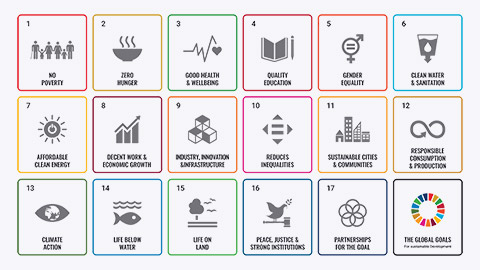
Sustainable marketing aims to meet present needs in a way that preserves the right and options of future generations and businesses. Socially and environmentally responsible actions and requires consumers, companies, public policy makers, and others to work together.
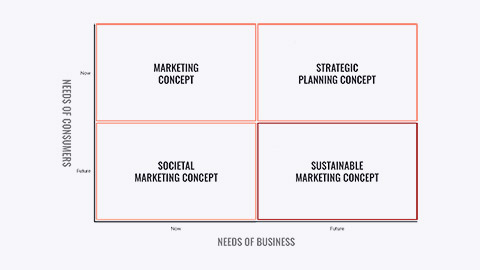
Have a look at the above image that compares the sustainable marketing concept with other marketing concepts. Read about each concept below:
- marketing concept- recognises that organisations thrive from day to day by determining the current needs and wants of target customers and fulfilling those needs and wants more effectively and efficiently than competitors do. It focuses on meeting the company’s short-term sales, growth, and profit needs by engaging customers and giving customers what they want now.
- societal marketing concept- considers the future welfare of consumers.
- strategic planning concept- considers future company needs.
- sustainable marketing concept- calls for socially and environmentally responsible actions that meet both the immediate and future needs of customers and the company.
McDonald’s sustainability initiatives

Good health and well-being are also one of the UN’s sustainable development goals. McDonald’s has a strong initiative on sustainability and has responded to its' challenges with a strategy of diversifying into salads, fruits, grilled chicken, low-fat milk, and other healthy fare, including Happy Meals, offering more balanced meals with simpler ingredients. The company has also sponsored major education campaigns to help consumers better understand the keys to living balanced, active lifestyles.
McDonald’s sustainability initiatives also address environmental issues. It calls for food-supply sustainability, reduced and environmentally sustainable packaging, reuse and recycling, and more responsible store designs. For example, McDonald’s has made the commitment to source all packaging from renewable or certified resources and make recycling an option at all locations by 2025.
Sustainable marketing principles
Under the sustainable marketing concept, a company’s marketing should support the best long-run performance of the marketing system. It should also be guided by five sustainable marketing principles, these are:
- Consumer-oriented marketing - the company will view and organise its marketing activities from the consumer’s point of view. It should work hard to sense, serve, and satisfy the needs of a defined group of customer value marketing.
- Customer value marketing - the company puts most of its resources into customer value-building marketing investments, creating value for consumers, therefor, the company can capture value from consumers in return.
- Innovative marketing - works off a principle where it requires that the company continuously seek real product and marketing improvements.
- Sense-of-mission marketing - defines a company’s mission in broad social terms.
- Societal marketing - marketing decisions are made by considering the consumers’ wants, consumer and/or societies long-run interests and company’s requirements
Developing a sustainable marketing mix
Marketers need to understand the attitudes of their customers toward sustainability and use this as a market strategy and ask themselves the following questions:
- What is the potential market for sustainability focused goods and services?
- What environmentally friendly products will consumers be likely to purchase, and which will they not?
Marketers can then successfully target green customers, that is, consumers who are most likely to actively look for and buy products that are eco-friendly.
Click on each of the four strategies used to find out how every business can help save the planet and benefit too:
Sustainable product strategies include the production of more environmentally friendly products, such as electric automobiles, and the use of environmentally friendly and recycled materials in products and in packaging. Long-term sustainability requires that marketers also understand how consumers use, store, and dispose of products.
Many consumers would like to buy green products, but they do not because the price is higher than comparable traditional products. Sustainable marketing practices aim to establish prices for green products that are the same or close to the prices of other products.
Sustainable distribution strategies can include retailers who focus on a reduction in the use of energy in order to benefit from both monetary savings and the loyalty of green consumers. Both producers and retailers can choose to buy from nearby suppliers to reduce dependence on long-haul trucking, which is a major source of air pollution.
The most obvious sustainable promotion strategies are those that inform customers of the firm’s commitment to the planet and future generations through advertising and other messages. But there are other opportunities. The cost of creating a TV commercial is enormous and may take two or three days of shooting to complete. Some firms have begun to “reuse” old commercials while letting customers know that this is their way of practising sustainability.
Sustainable customer behaviour
Marketers should motivate customers to seek out, pay for, and use sustainable options. When consumers become knowledgeable about environmental concerns and environmentally friendly products, they become part of sustainable marketing practices.
Sustainability at Unilever and their impact on society
Unilever is working with billions of customers worldwide to improve the social and environmental impact of its products.
Inspiring sustainable living
A summary of Unilever’s 5 levers for change.
Make it a habit
This lever is about reinforcing and reminding.
- Once people have made a change, what can we do to help them keep doing it?
Make it understood
This lever raises awareness and encourages acceptance.
- Do people know about this behaviour?
- Do they believe it’s relevant to them?
Make it easy
This lever establishes convenience and confidence.
- Do people know what to do and feel confident doing it?
- Can they see it fitting into their lives?
Make it desirable
This lever is about understanding people’s perceptions of themselves and their relationships with broader society.
- Will doing this new behaviour fit with their actual or aspirational self-image?
- Does it fit with how they relate to others or want to?
Make it rewarding
This lever demonstrated the proof and payoff.
- Do people know when they’re doing the behaviour right?
- Do they get some sort of reward for doing it?
Under Unilever’s Sustainable Living Plan, the consumer goods giant has set out to “create a better future every day for people around the world.” Unilever’s long-run commercial success depends on how well it manages the social and environmental impact of its actions and the implemented plan goes far beyond simply creating more responsible supply and distribution chains. For instance, approximately 68 percent of the total greenhouse gas footprint of Unilever’s products and 50 percent of the water footprint occur during post-purchase consumer use, therefor, Unilever is also working with its customers to improve the environmental impact of its products in use.
Societal classification of products
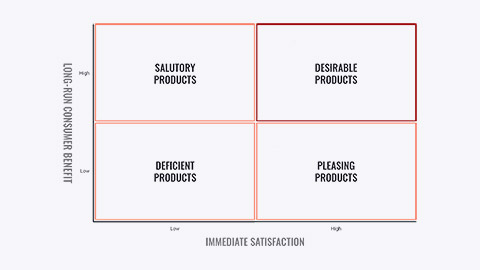
The above image shows how products can be classified according to their degree of immediate consumer satisfaction and long-run consumer benefit.
- Deficient products, such as bad-tasting and ineffective medicine, have neither immediate appeal nor long-run benefits.
- Pleasing products give high immediate satisfaction but may hurt consumers in the long run. Examples include cigarettes and junk food.
- Salutary products have low immediate appeal but may benefit consumers in the long run. Bicycle helmets or some insurance products are examples. The challenge posed by salutary products is to add some pleasing qualities so that they will become more desirable in consumers’ minds.
- Desirable products give both high immediate satisfaction and high long-run benefits, such as a tasty and nutritious breakfast food. Companies should try to turn all their products into desirable products.
Social criticisms of marketing based on their impact
Often companies will adopt marketing practices that are customer focused resulting in a trustworthy and profitable business. However, there are times where marketers steer their efforts to towards selfish motives. The outcome of this approach can lead to social criticism for the negative impact of their practices on customers. Such practices include:
Impact on individual consumers
- high prices
- deceptive practices
- high-pressure selling
- shoddy, harmful, or unsafe products
- planned and perceived obsolescence
- poor service to disadvantaged consumers
For example, a heavily promoted national brand sells for much more than a virtually identical store-branded product. Critics exclaim that much of this promotion and packaging adds to only the psychological value, not the functional value. Marketers respond that although advertising adds to product costs, it also adds value by informing potential buyers of the availability and merits of a brand.
Impact on society as a whole
- false wants and too much materialism
- too few social goods
- cultural pollution
Recreational Equipment Inc. (REI) is an outdoor recreation retailer, that impacted positively on society as a whole by refusing to open all their stores on Black Friday, taking a stance for what they believe in, their mission, which is to encourage their consumers to spend their time outdoors. They implemented marketing the awareness of their closure on social media using the fast trending hashtag #optoutside that worked well in their favour.
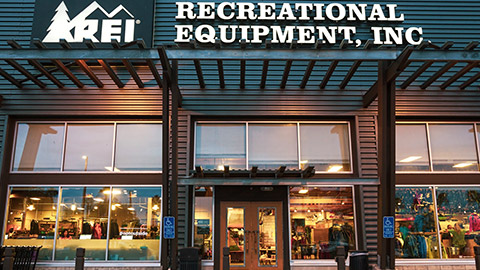
Impact on other businesses
- acquisitions of competitors
- marketing practices that create barriers to entry
- unfair competitive marketing practices
Does the following paragraph from this article say it all?
“In 2015, mergers and acquisitions globally involved more than $4 trillion of assets, and new research suggests these deals have large, negative effects on consumers: Price increases of 15 percent to 50 percent with no corresponding increase in the quality of the goods being sold.” Consider how this may affect their customer relationship and potentially the brand itself?
Environmentalism is an organised movement of concerned citizens, businesses, and government agencies designed to protect and improve people’s current and future living environment. Environmentalists are concerned with marketing’s effects on the environment and the environmental costs of serving consumer needs and wants and want people, as well as organisations, to operate with more care for the environment. Some concerns include damage to the ecosystem caused by global warming, resource depletion, toxic and solid wastes, litter, the availability of fresh water, and other problems such as the loss of recreational areas and the increase in health problems caused by bad air, polluted water, and chemically treated food. Concerns related to the environment have resulted in federal and state laws and regulations governing industrial commercial practices impacting the environment. In recent years, most companies have accepted responsibility for doing no harm to the environment and an increasing number of companies are now adopting policies of environmental sustainability. Environmental sustainability is a management approach that involves developing strategies that both sustain the environment and produce profits for the company.
Environmental sustainability and sustainable value
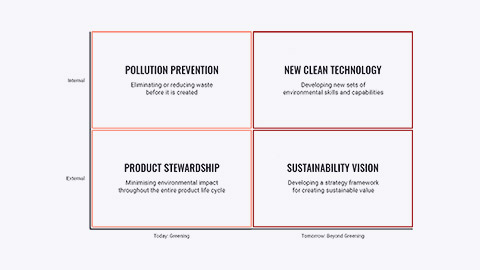
This above image depicts a framework that companies can use to gauge their progress towards environmental sustainability. It includes both internal and external greening activities that will benefit the firm and environment in the short run, along with 'beyond greening activities' that will be of benefit both in the longer term. At the most basic level, a company can practice pollution prevention, therefor, eliminating and/or minimising waste before it is created. Companies emphasising prevention have responded with internal green marketing programs, for example:
- designing and developing ecologically safer products
- recyclable and biodegradable packaging
- better pollution controls
- more energy-efficient operations.
Furthermore, companies can practice product stewardship, which involves minimising not only pollution from production and product design but also all environmental impacts throughout the full product life cycle, while at the same time reducing costs. Many companies are adopting design for environment (DFE) and cradle-to-cradle practices. This involves thinking ahead to design products that are easier to recover, reuse, recycle, or safely return to nature after usage, thus becoming part of the ecological cycle. The beyond greening activities identified look to the future. Internally, companies can plan for new clean technology, more than just natural environmental challenges, it also points the company to opportunities creating sustainable value for markets and the firm through environmental sustainable strategies and practices. Companies can develop a sustainability vision, which serves as a guide to the future. It shows how the company’s products and services, processes, and policies must evolve.
Marketers at times will face difficult issues during their careers. Have a look at the below hypothetical situations you may come across, it may prepare you for some morally difficult situations in marketing.
- Your R&D department has changed one of your company’s products slightly. It is not really “new and improved,” but you know that putting this statement on the package and in advertising will increase sales. What would you do?
- You are thinking of hiring a product manager who has just left a competitor’s company. She would be more than happy to tell you all the competitor’s plans for the coming year. What would you do?
- One of your top dealers in an important territory recently has had family troubles and his sales have slipped. It looks like it will take him a while to straighten out his family problems. Meanwhile, you are losing many sales. Legally, on performance grounds, you can terminate the dealer’s franchise and replace him. What would you do?
- You have a chance to win a big account in another country that will mean a lot to you and your company. The purchasing agent hints that a “gift” would influence the decision. Such gifts are common in that country and some of your competitors will probably make one. What would you do?
- You have to choose between three advertising and social media campaigns outlined by your agency. (Pretests show that the campaigns are effective in the following order: (C), (B), and (A). What would you do?)
- A soft-sell, honest, straight information campaign.
- The use of emotion-loaded appeals then exaggerates the product’s benefits.
- One that involves noisy, somewhat irritating commercial and pop-ups that are sure to gain audience attention.
- You are interviewing a capable female applicant for a job as salesperson. She is better qualified than the men who have been interviewed. Nevertheless, you know that in your industry some important customers prefer dealing with men and you will lose some sales if you hire her. What would you do?
It is vital to understand that marketing planning ethics should be a first consideration as some outcomes of marketing can be impacted if ethics are not considered. For example, an unethical marketing action cannot establish long-term relationship and consequences of low ethical standards can be damaging to firms and managers, sequentially, the following three unfortunate situations may occur.
- Stockholders may lose investment
- Jobs may be lost.
- Confidence in the economy suffers
Businesses touch many stakeholders and need to do what’s best for all of them where possible. However, sometimes the interests of various stakeholders and the firm may not align. This can lead to unethical behaviour on the part of marketers and other firm employees.
For example, Wal-Mart was the target of a US DOJ ( Department of Justice) investigation that alleged the company bribed Mexican officials in order to open more stores. Also, GlaxoSmithKline, a multinational pharmaceutical company, pled guilty to the promotion of drugs for unapproved uses, failure to report safety data, and improper marketing. How do you feel these companies conducted themselves ethically?
Ethical marketing practices
Managers need a set of principles that will help them determine the moral importance of each situation and decide how far they can go in good conscience. One philosophy is that the free market and the legal system should decide such issues, and it is under this principle, companies and their managers are not responsible for making moral judgments however, companies can, in good conscience, do whatever the market and legal systems allow. Another philosophy puts responsibility not on the system but in the hands of individual companies and managers and suggests that a company should have a social conscience. Companies and managers should apply high standards of ethics and morality when making corporate decisions, regardless of what the system allows. Dealing with issues of ethics and social responsibility, in an open and forthright way, helps to build and maintain strong customer relationships based on honesty and trust. As with environmentalism, the issue of ethics presents special challenges for international marketers. Business standards and practices vary a great deal from one country to the next.
Importance of ethical marketing practices
Ethics can be viewed differently by an individuals due to many influencing factors such as their own culture, values and so on and because this then governs a person's behaviour it becomes more so important to factor this in marketing. Below are three practices to be mindful of regarding ethics when marketing.
- Business ethics are basic values that guide a firm’s behaviour. It can be tricky at times as what constitutes ethical behaviour as it is often different for different people, with ethical philosophies being the driving force, guiding how people make such decisions.
- Ethical relativism relates to the morality of one’s culture. What is ethical in one culture is not necessarily the same in another culture
- In an organisation there must be a written standard code of ethics to assist in maintaining integrity, which everyone in the organisation must subscribe. Often a firm will develop their own code of ethics, for instance, AT&T, an American Telephone and Telegraph company’s Code of Business Conduct details its commitment to honesty and its commitments to each other, to the business, its shareholders, to its customers, to its communities, to others, and to the code itself. Another example of ethics being applied to a firm is when we look at many universities, most have a statement on what constitutes ethical behaviour by students and by faculty and staff.
See below to view how the American Marketing Association (AMA) have highlighted their statement of ethics.
Ethical Norms
- Do no harm
- Foster trust in the marketing system
- Embrace ethical values
Ethical Values
- Honesty
- Responsibility
- Fairness
- Respect
- Transparency
- Citizenship
Most companies have their mission and value statements available online for viewing, have a look these for some of your favourite companies including universities, what do you think of their ethical statements and practices? Do they do as they say they will do? How do their statements make you feel as a potential customer?
Major marketing decision areas that may be called into question under the law

Legal issues related to selling decisions and advertising decisions arise when market planning that require many questions to be answered before getting started.
Click on each of the headings below to discover questions you may ask yourself when making these marketing decisions in relation to relevant legal requirements.
- Bribing?
- Stealing trade secreted?
- Disparaging customers?
- Misrepresenting?
- Disclosure of customer rights?
- Unfair discrimination?
- Consumer Privacy?
- Deceptive advertising?
- Bait-and-switch advertising?
- Promotional allowances and services?
- Exclusive territorial distributorship?
- Tying agreements?
- Dealer’s rights?
- Anticompetitive acquisition?
- Barrier to entry?
- Predatory competition?
- Product additions and deletions?
- Patent protection?
- Product quality and safety?
- Product warranty?
- Fair packaging and labelling?
- Excessive cost?
- Scarce resources?
- Pollution?
- Price fixing?
- Predatory pricing?
- Price discrimination?
- Minimum pricing?
- Price increases?
- Deceptive pricing?
Unethical marketing
Though many companies work hard in achieving an ethical marketing approach, there have been moments where some companies do not achieve this all that well. View the several examples below of the most common criticisms of marketing.
Marketing serves the rich and exploits the poor
Many marketers are concerned about their bottom line, but they also want to provide a better quality of life for all consumers, that is, the societal marketing concept, but there are exceptions. For example, because of decreasing sales of cigarettes in developed countries, tobacco companies target smokers in LDCs (least developed countries) and developing countries and thus contribute to the health problems of those populations.
Products are not safe
Whether marketers are truly dedicated to providing their customers with the safest products possible or because of the fear of government regulation and liability issues, most firms do make safe products and, if they find a problem, quickly notify customers and recall the defective product. GM, however, in 2014 found itself embroiled in a huge scandal after choosing in 2005 not to recall 2.6 million cars with ignition switches that were known to be faulty. Instead, GM continued to use the switches, which could cut off power to the engine, disabling the airbags and power steering and brakes. The faulty switches were linked to at least 13 deaths.
Poor-quality products
Many people express the loss of U.S. manufacturing, feeling that imported products such as textiles and furniture are of poor quality. Product quality, however, is determined by what consumers want in a product. Do you want a refrigerator that lasts 50 years?
Planned obsolescence
To remain profitable, marketers must offer new products after an existing product has been on the market for a period of time. For example, just when we all decided we had to trade in our old HCD TV for an LED smart TV, the OLED (organic light-emitting diode) TVs are hitting the market at prices beginning around $5,000. For many people, this is a good thing, as it increases their enjoyment of TV.
Marketing creates interest in products that pollute the environment
Yes, it is true that those gas-guzzling SUVs remain on the market and that commercial fertilizers, pesticides, and insecticides continue to pollute the environment as farmers try to produce better and more food. Many would argue, however, that those chemicals would not be available unless there was a demand for them. Moreover, the use of these chemicals increases crop yields and helps in reducing global hunger.
Easy consumer credit makes people buy things they do not need and cannot afford
Many are concerned about businesses such as payday loan and car title loan companies that charge interest rates that can exceed 400 percent annually. Their customers typically are people with limited financial resources and even less knowledge about how to manage their money.
The sustainable company
Sustainable companies are those that create value for customers through socially, environmentally, and ethically responsible actions. Sustainable marketing goes beyond caring for the needs and wants of today’s customers. It means pursuing the mission of a triple bottom line which is people, planet, and profits. Sustainable marketing provides the context in which companies can build profitable customer relationships by creating value for customers to capture value from customers in return, both now, and in the future.
Marketers do well by doing good
Unfortunately, many companies still believe sustainability is no longer an option, however, it is highly suggested that firms focus on the triple bottom line (people, planet and profits) as it is considered sensible business to start your marketing plan with sustainability in mind.
Have a read of how the great COVID-19 reset can help firms build a more sustainable future.
The-COVID-19-Reset-Sustainability
Further readings on sustainability, tips, benefits and research.
Getting the Most Out of Your Sustainability Program
Yes, Sustainability Can Be a Strategy

